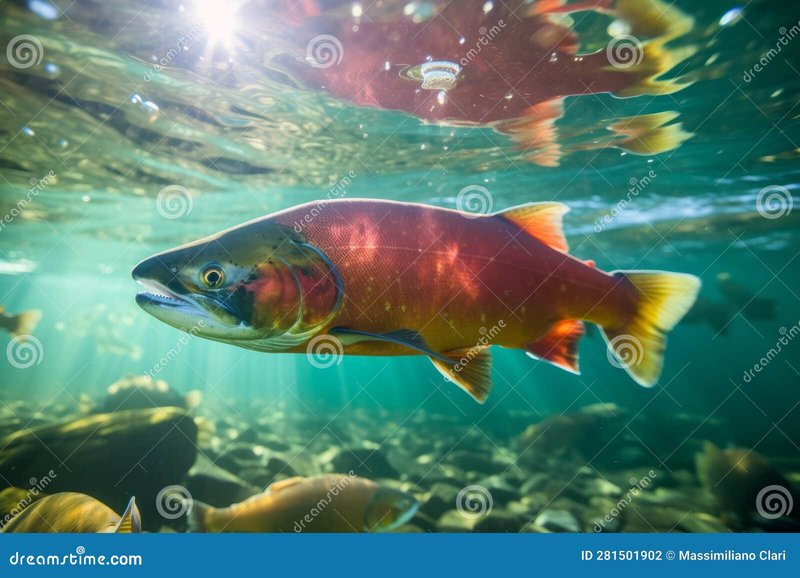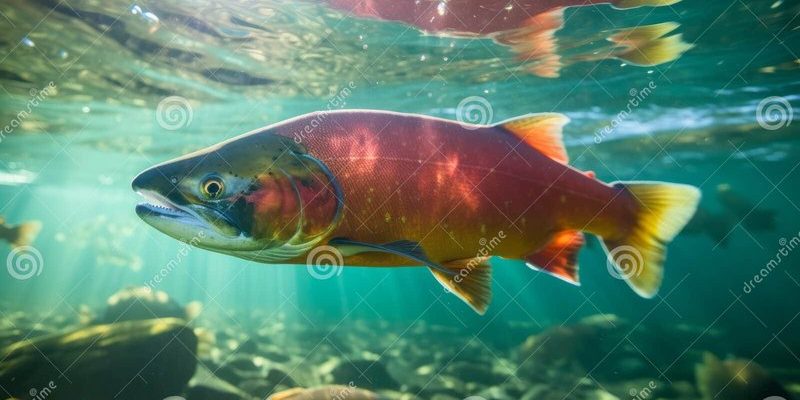
Imagine you’re at a serene riverbank, the sun glinting off the water like little diamonds. You spot a salmon flipping gracefully in the current. It might seem tempting to reach out and touch this beautiful fish, but wait! It’s essential to know how to interact with salmon safely and responsibly. By understanding their behavior and habitat, we can enjoy witnessing these incredible creatures without causing them harm.
So, let’s dive into this topic and unravel the question: Can humans interact safely with salmon? We’ll look at their habitats, behaviors, and the best ways to observe them without disrupting their lives.
Understanding Salmon and Their Environment
Salmon are fascinating creatures that play a vital role in many ecosystems. They’re known for their impressive migration journey, traveling from rivers to the ocean and back again to spawn. This remarkable journey highlights the connection between freshwater and saltwater environments. Salmon typically thrive in cold, clean waters, making rivers and streams their primary habitats.
Think of their habitat like a cozy home. Salmon need specific conditions to survive, such as good water quality and plenty of food. Keeping rivers clean and preserving natural habitats is crucial for maintaining healthy salmon populations. As we interact with rivers, it’s essential to remember that we’re guests in their home, and respecting their space is vital.
From an ecological standpoint, salmon are also important for other species. As they swim upstream to spawn, they contribute nutrients to the water and surrounding land. When they die, their bodies decompose, releasing essential nutrients back into the ecosystem. This nutrient cycle supports various wildlife, plants, and even other fish. It’s like a natural give-and-take process that keeps the environment balanced.
How to Observe Salmon Responsibly
Observing salmon in their natural habitat can be an exhilarating experience. Whether you’re fishing or simply watching them in a river, knowing how to do it responsibly is key. Here are some tips for safe and respectful interactions:
- Keep Your Distance: When watching salmon, maintain a respectful distance. Getting too close can stress them out and disrupt their natural behavior.
- Use Quiet Voices: Salmon can be sensitive to noise. Use soft voices and avoid shouting or making sudden movements that might scare them away.
- Watch From the Bank: Instead of wading into the water, find a comfortable spot along the riverbank. This way, you can enjoy the view without disturbing the salmon.
By following these simple guidelines, you can turn a regular outing into a positive experience for both you and the salmon. It’s all about being a good observer and appreciating their beauty without interfering with their lives.
The Role of Anglers and Salmon Conservation
If you’re an angler, the relationship between humans and salmon becomes even more important. Fishing can have significant impacts on salmon populations, so understanding sustainable fishing practices is essential. Here are a few key points to consider:
1. Catch-and-Release: Many anglers practice catch-and-release fishing, which helps maintain salmon populations. This method allows you to enjoy the thrill of fishing while ensuring that the fish can swim away to spawn again.
2. Follow Local Regulations: Checking fishing regulations in your area is critical. These rules often include size limits, seasonal restrictions, and specific areas for fishing. Following these guidelines helps protect spawning salmon.
3. Use Barbless Hooks: If you’re catching salmon, using barbless hooks can reduce injury to the fish. They make it easier to remove the hook and cause less damage, which improves the fish’s chances of survival after release.
Taking these steps not only supports the salmon population but also enhances your fishing experience. You’re not just angling for a catch; you’re participating in a larger conversation about salmon conservation.
Is It Safe to Touch or Handle Salmon?
You might be curious about whether it’s safe to touch or handle salmon. While it might seem like a fun idea for a selfie or a memorable experience, there are a few factors to keep in mind:
1. Stress to the Fish: Handling salmon can cause significant stress. Fish are delicate creatures, and even brief handling can impact their health. Stress can weaken their immune systems and make them more susceptible to disease.
2. Mucus Layer: Salmon, like many fish, have a protective mucus layer on their skin. This layer helps prevent infections. Touching them can remove this layer, exposing them to potential harm.
3. Legal Restrictions: In some areas, laws may prevent you from touching or handling wild salmon, especially during spawning seasons. It’s always best to respect these regulations.
If you want to interact with salmon, your best bet is observing them from a distance or using gear that doesn’t disturb them. Let these beautiful fish navigate their world while you enjoy watching their graceful movements.
How Climate Change Affects Salmon Interactions
Climate change is a hot topic that affects countless species, including salmon. As temperatures rise, salmon habitats are changing, and this can impact how we interact with them. Here’s what you should know:
– Water Temperature: Salmon thrive in cold waters, and rising temperatures can lead to heated river systems. Fish that can’t adapt to these changes may struggle to survive, impacting their migration patterns and spawning success.
– Oxygen Levels: Warmer waters typically hold less dissolved oxygen, which is crucial for salmon. Low oxygen levels can force fish to seek cooler areas, making them less accessible for observation or fishing.
– Ecosystem Disruption: Climate change can alter entire ecosystems, affecting not only salmon but also the species that rely on them. This interconnected web means that protecting salmon habitats is vital for maintaining balance in nature.
By staying informed about climate change impacts, you can help support efforts to protect salmon and their environments. Small changes in our daily habits can contribute to making a difference.
The Importance of Community and Education
Engaging with your community and seeking education about salmon habitats can make a powerful impact. By joining local organizations or participating in conservation efforts, you can help protect salmon while learning more about them.
– Community Events: Many organizations host events focusing on salmon education. From river clean-ups to educational workshops, participating can enhance your understanding and deepen your appreciation for these wonderful fish.
– School Programs: If you’re interested in education, communities often offer programs in schools that teach children about salmon habitats and conservation. Fostering this knowledge at a young age helps build a culture of respect for wildlife.
– Online Resources: The internet is filled with resources dedicated to salmon conservation. Websites, documentaries, and webinars can provide valuable insights into salmon behavior and the challenges they face.
By participating in these activities, you not only create a better understanding of salmon but also contribute toward preserving their habitats for future generations.
Interacting with salmon can be a fantastic experience, but it comes with responsibility. By understanding their habitats, practicing sustainable fishing, and respecting their space, we can enjoy these beautiful creatures without compromising their well-being.
As you venture out to rivers or streams, remember that salmon are more than just fish—they’re vital members of ecosystems that deserve respect and protection. Whether you’re watching them swim or casting a line, let your interactions be guided by care and consideration. By doing so, you help ensure that future generations will have the same opportunity to marvel at the beauty of salmon in their natural environment.

